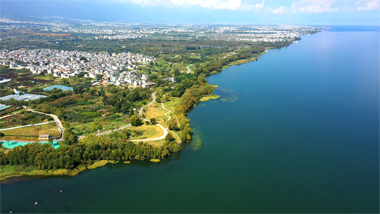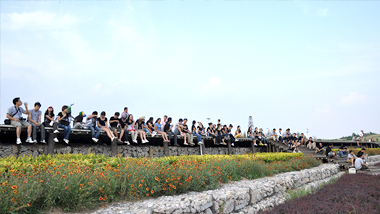
Beijing ZEHO Waterfront Ecological Environment Treatment Co., Ltd. was established in 1997 and is positioned as an "urban waterfront space operator". It is a national high-tech enterprise and a Beijing enterprise technology center.The company has been deeply engaged in the field of ecological environment for 27 years, with the concept of sustainable development at its core and guided by Nature-based Solutions (NbS). It has established three major business segments: ecological environment governance, ecological water infrastructure, and urban waterfront spaces, offering customers a systematic solution encompassing "technology + design + construction + operation + business", and is committed to facilitating sustainable development between humans and nature through intelligent ecology.
Learn more >
With 27 years of experience in the ecological environment field, ZEHO ECO upholds the concept of sustainable development as its core and is guided by Nature-based Solutions.
Learn more >
We dived deep into the eco-environment industry and built up a service system covering the whole industry chain of design, build, intelligence, investment, and operation.
Learn more >

We stimulate the vitality of organizations and individuals through professional training system and career development path, and help employees and enterprises grow together.
Learn more >
If you have any questions about our business, products, technologies and cooperation, please contact us through the following channels.
Learn more >
China Natural Resources News, media under the Ministry of Natural Resources, published a full-page topic on October 15th: ZEHO’s Practice of Biodiversity Protection — Enlightenment from the Ecological Conservation and Restoration Case of ZEHO ECO’s ‘Nature-based Solutions’. In the interview report, ZEHO ECO used a series of biodiversity protection cases to explain measures and their applications from the perspective of practitioners in order to summarize successful practices that can be replicated and promoted, and provide a reference for relevant practitioners.

October 15th ZEHO ECO Full-page Report © China Natural Resources News
Attached article: Original text of China Natural Resources News
Reporter: An Haiyan, Chen Chen; Correspondent: Wang Shujie

Ecological restoration of lakefront buffer zone of Erhai Lake in Dali, Yunnan

Xiao River National Wetland Park, Shanxi

Ecological restoration project of Nanhu Lake in Tangshan, Hebei

Ecological conservation of Tanghe-River-Baiyang-Lake Wetland in Xiong’an New Area, Hebei
“Each of the myriad of things must be in a harmonious relation with nature in order to grow, and each must get from nature the proper nurture in order to become complete.” On October 11th~15th, the first phase of the 15th meeting of the Conference of the Parties to the UN Convention on Biological Diversity (COP15) opened in Kunming, Yunnan Province. The meeting’s theme was “Ecological Civilization-Building a Shared Future for All Life on Earth”. The first phase of the meeting included the opening ceremony, closing ceremony, ministerial meeting, ecological civilization forum and other events. Beijing ZEHO Waterfront Ecological Environment Treatment Co., Ltd. (referred to as ZEHO ECO), a co-organizer of the forum, participated in the opening ceremony and delivered a keynote speech at the forum themed “Ecological Conservation and Restoration with Nature-based Solutions”, introducing corporate samples in biodiversity conservation to the world.
Over the past 24 years, ZEHO ECO has integrated the traditional Chinese philosophy of “Nature and Man as One” into the corporate development philosophy and implemented many biodiversity conservation projects with Nature-based Solutions. From the perspective of practitioners, ZEHO ECO used a series of biodiversity protection cases to explain measures and their applications in order to summarize successful practices that can be replicated and promoted, and provide a reference for relevant practitioners.
Tao follows nature. Our original intention doesn’t change.
Nature-based Solutions were clarified for the harmonious coexistence of man and nature
In June, 1992, at the United Nations Conference on Environment and Development held in Rio de Janeiro, Brazil, the Convention on Biological Diversity was opened to all countries for signing. China became one of the first countries to sign.
Biodiversity is the material basis for human survival and development, and it plays a significant role in regulating the ecological environment. It can be said that protecting biodiversity is the protection of human species itself. Biodiversity has become a social issue closely related to human life and survival. It has not only been the focus and hotspot of academic research, but is also firmly believed by many people of insight to be a vast space for business development.
As an eco-environmental technology operator, ZEHO ECO has upheld its original aspirations and commitments for many years, and has allowed numbers of ecological conservation and restoration projects to take root.
As we all know, ecological conservation and restoration highly depend on technological innovation. And business development faces policy opportunities and challenges, the formation of industrial ecosystems, and the confusion of large investment scale and long return cycles. Since its birth, ZEHO ECO has established the principle of pursuing the essence of design and has been integrating scientific design methods, integrated solutions, and quasi-natural ecological technology and construction methods into every project. In the design process, ZEHO ECO adheres to science, digitization, innovation and multidisciplinary integration, and strives to protect and restore the diversity and dynamic balance of the ecosystem of our country, in order to realize the harmonious coexistence of man and nature. And in the construction of projects, ZEHO ECO adopts quasi-natural ecological construction methods to maximize the restoration of the natural environment, the construction of ecosystems, and protecting biodiversity.
Speaking of the projects implemented in the past 24 years, the company’s board chairperson couldn’t hide her pride and familiarity:
The ecological restoration and comprehensive remediation project of Nanhu Lake in Tangshan, Hebei Province, started in 2008, transformed the former coal-mining subsidence area and abandoned industrial and mining land into a “green lung” and “oxygen bar” in the center of Tangshan City. Now, over 220 kinds of lush plants thrive in the area. The greening rate has reached 65%. The water area is 11.5 square kilometers. And over 100 species of wild birds back and forth for inhabitance… The project was selected into the list of Typical Cases of Ecological Product Value Realization (Second Batch) issued by the Ministry of Natural Resources in 2020.
Xiao River, the mother river of Xiaoyi City, Shanxi Province, was still a coal washing pollution area in 2011. ZEHO ECO strictly followed the strategy of “ecology and water conservancy first, nature protection, minimal intervention and sustainable development”, and scientifically protected and restored water bodies, landforms, biological resources, historical culture, etc. When two gigantic trees obstructed the boardwalk construction, the project team did not blindly implement the original plan of relocating the trees, but persisted in building the boardwalk in the middle of the trees. The year after the project was completed, the occupancy rate of the artificial bird nests on the trees reached 80%.
Guided by ecological restoration, the conceptual design of the landscape “Nine Waters for One Heart” in Jiaxing City, Zhejiang Province, is committed to creating a landscape of new towns on the water with Jiangnan (an area to the south of the Yangtze River) characteristics. Besides opening up links and waterfronts, the project combined naturalized shorelines with purified wetlands to purify water quality, and restored the urban riverside ecosystem with waterfront plant communities that are Jiangnan’s special features, and built a bio-friendly blue and green corridor, improving the comfort of the microclimate and letting people appreciate the idea that the most beautiful scenery is the one in which they play a part along their way of life, and thus create a successful case of cultural landscape: “people are part of the scenery, and their moving is the experience of the landscape”...
In pursuing the goal of the “sustainable development of man and nature”, ZEHO ECO has never stopped exploring the development prospects of the industry. The company farsightedly introduces innovative concepts such as Nature-based Solutions and systematic working methods such as symbiotic cities.
Nature-based Solutions are an umbrella concept that actively uses natural ecosystems and artificial ecosystem services to achieve sustainable development goals and encompasses many ecosystem-based methods such as ecosystem-based adaptation, ecosystem-based disaster risk mitigation, natural infrastructure, green infrastructure, and nature-based climate change solutions.
In 2008, ZEHO ECO’s chairperson led the company’s core design team to study abroad and systematically learn the concept of sustainable development and international planning and construction practices in related fields. Hammarby Sjostad in Stockholm, Sweden, a world-class model project in sustainable development, left a deep impression on the group.
Since 2010, the company has successively established strategic partnerships with many leading international technology companies, and organized international work camps for key projects in domestic sustainable development, jointly proposing localized solutions that not only embody world leading concepts, but also can adapt to China’s local environments, and effectively solve environmental and ecological problems. In the design and construction of projects, the work camps full used Nature-based Solutions and continued to pay attention to protecting biodiversity. Lots of innovative technologies have been implemented in a series of projects, such as those in Dali’s Erhai Lake in Yunnan, Baiyang Lake in Xiong’an New Area in Hebei, Nansha in Guangzhou, Putian in Fujian. Through ecological reconstruction, regeneration assistance, natural restoration, protection and conservation and other measures, the lakes’ shorelines were restored into natural lakeshore zones for water purification and ecological recovery, providing technical exemplars for ecological restoration.
Since then, the innovative development path of ZEHO ECO has formed a scientific closed loop from concepts, measures and realization methods to technical systems and data. Through a team of highly educated and multi-professional talents, integrated solutions of “Landscape, Architecture, Energy, Waste, Water, Transportation, Urban Function, Intelligence” are coordinated to realize a beneficial cycle.
River and lake ecological restoration case — Erhai Lake
One ecological corridor connecting biodiversity — humans in symbiosis with the lake by retreating and making room for it
On October 9th, the “Erhai Lake Ecological Corridor Online Science Museum” mini program was launched. When you open the mini program, you see profuse pictures and texts in both Chinese and English that introduces the biodiversity, culture and customs of Erhai Lake and its surroundings.
As the “Mother Lake” of Dali, Yunnan, the beautiful Erhai Lake attracts a great number of tourists every year. However, since the 1980s, because of the continuous expansion of cities and towns, the disorderly development of the tourism industry, and agricultural non-point source pollution, Erhai Lake has once suffered the phenomenon of “people advancing and the lake retreating”, and the water quality faced severe challenges.
On January 20th, 2015, General Secretary Xi Jinping visited the Erhai area in Dali Bai Autonomous Prefecture, Yunnan Province and ardently entrusted Dali’s officials and residents with the task to “protect Erhai Lake so that the natural beauty described in the verse ‘Cangshan Mountain paints millennia of paintings without ink, and Erhai Lake plays aeons of music without strings’ can stay in this world forever”. Immediately, Dali Prefecture switched to “rescue mode” to save Erhai Lake and started the “Eight Major Battles”, and the ecological restoration of the Erhai Lake Riparian Buffer Zone of Dali was one of the major projects.
The lakefront buffer zone ecological restoration demonstration project ZEHO ECO undertook is in Erbin Village, Xiaguan Town, Dali City, Yunnan Province. It is the starting point of the entire Erhai lakefront buffer zone project. ZEHO ECO deeply analyzed Nature-based Solutions and adopted the five core ecological restoration strategies of “reshaping natural space, perfecting a healthy lake ecosystem, forming a sustainable self-management system, adding low-interference service systems, and protecting the sacred natural heritage of Erhai Lake”. The company probed the significance of biodiversity for the conservation of Erhai Lake, and used measures such as ecological reconstruction, regeneration assistance, natural restoration, and protection and conservation to gradually restore the lakefront buffer zone to its natural state, and habitats such as lake beaches and wetlands came back after “years of disappearance”. Not only has this reduced the load of pollution into the lake, but has also improved the “face score” of Erhai Lake, reminding people to cherish and care for the ecological environment and gradually form a healthy and sound composite ecosystem of the society, the economy and nature.
One year after the completion of the project, the wetland water quality indicators became stable, the plant communities on the lakefront became more abundant, and the number of species and scale of the bird communities that inhabit the place expanded. As a habitat in the aquatic terrestrial ecotone, the lakefront compensates for losing natural beaches caused by “people advancing and the lake retreating”. Here, Nature-based Solutions have taken an important step forward from concept to practice. The lakefront has changed from an occupation mode of “people advancing and the lake retreating” into a symbiotic mode of “people retreating and the lake returning”.
The restored lakefront buffer zone is the last ecological safety barrier of Erhai Lake and an ecological treasure for sustainable development.
Ecological wetland conservation case — Baiyang Lake
A low-impact, close-to-nature and sustainable wetland ecosystem
The Tanghe-River-Baiyang-Lake Wetland in Xiong’an New Area is where Tanghe River and Baiyang Lake meet. In the construction of Xiong’an New Area, the wetland will undertake functions such as eco-tourism and science popularization. Because of the long-term disturbance of human activities, the natural wetland has transformed into farmland, dry land, etc., and the wetland ecosystem has been seriously degraded.
Aiming at problems such as the degradation of the ecological environment and the reduction of biodiversity in the Tanghe-River-Baiyang-Lake Wetland, ZEHO ECO took the conservation and restoration of the wetland as its vision and achieved the goal of building a healthy ecosystem and a sustainable wetland protection system by turning farmland back into wetland, restoring the form of natural water systems, restoring the water body’s self-purification capacity, restoring the diversified biological habitat of wetland, and restoring the complete food chain system of the ecosystem.
With the minimum human intervention as its principle, ZEHO ECO fully considered and made use of the local conditions, the environment, the climate and other factors, and strove to reduce interference with the natural environment in order to better protect and restore the wetland. By setting up ecological buffer zones and rationally dividing areas by their functions, the company intercepted point and non-point source pollutions such as initial rainwater and domestic sewage in surrounding villages and towns and effectively controlled and took precautions against potential pollutants through ecological means to ensure the orderly operation of the normal functions of wetlands. In addition, by joining smart monitoring and popular science display and integrating an environmental science education and scientific research monitoring system, ZEHO ECO has formed a diversified science education experience area with birds, amphibians, aquatic creatures, insects, plants, etc. and is committed to turning the Tanghe-River-Baiyang-Lake Wetland into a close-to-nature, low-impact, sustainable wetland ecosystem restoration demonstration area.
The implementation of the project optimized Baiyang Lake’s ecological structure, promoted the environmental remediation and ecological restoration of the lake, and created an exemplar for close-to-nature wetland habitats in the lake area and even the whole Northern China.
Case Study of Islands and Bays for Coastal Zone Management
Science Empowers Ecology, Innovative Eco-engineering, Smart Ecology Management
Unlike the regions ashore, coastal zone management faces more complicated circumstances.
In recent years, Nansha District in Guangzhou has witnessed a high-quality development of a maritime economy with clustering of maritime industry. In accordance with the “Ecological Belt” concept put forward by Guangdong provincial government, Nansha District, the key development zone in Guangzhou, will pilot the Jiangmen Waterway to the west and north of Lingshan Island and the Shanghengli Waterway to the south.
ZEHO ECO undertook the ecological restoration project of the outer river along the tip of Lingshan Island. The project was to restore the ecological space and maintain the natural landscape for the outer river outside the dam. Through ecological construction methods, the company reconstructed the ecological basis and built a favorable aquatic environment for the plant communities. The vegetation covered the paved rocks during the ebb. It created a sound natural environment for the aquatic ecological space and adopted proper measures to guarantee the water is clean and no garbage patch.
The project integrated hydrology and meteorology and selects stable and environmental-friendly ecological construction methods for solidification to reshape the ecological basis and provide a favorable aquatic environment for the plant community in the outer river region. In order to prevent soil erosion and provide essential soil conditions for vegetations to grow, the project adopted ecological construction methods of Geocell and branch-sediment based on specific water-flows.
The vegetations on Lingshan island were designed to cover the paved rocks during the ebb. Based on the specific features of mangroves and aquatic plants, including adaptation to salinity, resistance to submerging, waterlogging and wind, various species such as iris, reed, Typha angustifolia, Cyperus malaccensis, Aegiceras corniculatum, Acanthus ilicifolius and Volkameria inermis, the project built an all-round ecology. The project also selected appropriate types of vegetation in accordance with the specific coastline and detailed natural conditions to balance scenery and ecology. For the graded shoreline, the project adopted the flower-border vegetation arrangement to enrich the foreshore experience, with the broad vision as the prerequisite. The general design fully protects the natural landscape of the island by growing moisture-loving and aquatic plants underneath the fence to cover the muddy coasts to keep the man-made vegetations in line with the original scenery.
The entire project completed by the end of 2020. 5.5 kilometers of coastline were restored, with 4.0 kilometers restored by ecological construction methods and the remaining 1.5 renovated. Through the project, the area of 22,105 m2 was anew covered with vegetations. Thanks to the ecological restoration, the biodiversity on the tip of Lingshan Island rocketed. The species of mudflat plants and mangroves grew to 17, including eight mangrove and semi-mangrove, while the other nine aquatic. According to observation, fiddler crab and other five benthic species were found. The vegetations along the river decorate the outer river region of the tip of Lingshan Island as a beautiful jade necklace. The grand and greenery outer river scenery embraces the ribbon-shaped park alongside the dam, and together they demonstrate a diversified waterfront experience zone.
The “Blue Bay” Project in Putian, Fujian Province is another successful exemplar of coastal zone management.
Putian “Blue Bay” (North Side) Ecological Environment Big Data Platform developed by ZEHO ECO can monitor environmental performance indices including those of water and air along the coast precisely and monitor the ecological indices such as plant and animal species dynamically. The platform helps provide data support for restoring and creating ecology along the coastal region in Putian with scientific guidance. Through ecological environment data monitoring, collection and analysis, the platform can realize the purpose of balancing the “Blue Bay” environmental management and the coastal zone ecological restoration. The platform made up of various systems, including maritime environmental impact factor tracking and monitoring system, maritime data comprehensive management system and maritime ecological restoration evaluation system.
This is an innovative breakthrough of the project – Putian “Blue Bay” (North Side) Ecological Environment Big Data Platform serves as a big data application system to support the platform of data comprehensive management center. It first gains data from multiple systems through simulation, inquiry and comparison, and then integrates, stores and manages them to realize the comprehensive management of data collected from monitoring. Maritime environmental impact factor tracking and monitoring system offers data inquiry and display, supports single and multiple factor inquiry methods to visualize the inquiry result based on GIS maps, tables, bar charts, run charts, etc.
With the help of “Smart Ecology” technology, the project has yielded fruitful outcomes.
Data visualization – It provides a panoramic display of key hydrological and water quality indices of “Blue Bay” (North Side), including waves, wind intensity and water temperature. Also, it promotes the brand of Mazu culture and presents real-time ecological construction methods, tide curve and biological sample monitoring data of Da’aihu Wetland.
Monitoring and early warning – It clearly shows a variety of precise locations and relevant data of those monitoring buoy within the region, shows the operation of all online devices, and visualizes the total carbon sequestration amount, carbon storage and aggregate carbon sequestration value.
Ecological restoration and evaluation – It compares all “Blue Bay” indices before and after the restoration through data charts and thoroughly displays the evaluation standards for index grade level of the “Blue Bay”.
Biodiversity protection – by encouraging the public to take part, photos and videos of plants, birds, fishes and benthic species have been collected and uploaded into the system to directly figure out the species dispersion within the region.
The undergoing COP15 aims at promoting the formulation of the “Post-2020 Global Biodiversity Framework” to set goals and clarify the path for global biodiversity protection in the future. This is of significance to strengthening the faith of ZEHO ECO.
As an A-share listed eco-environmental technology operator, ZEHO ECO has been deeply involved in eco-environment for 24 years. On the way to protect the ecological environment, ZEHO upholds the shared philosophy to harmonize humans and all life in nature, keeps improving its capabilities in planning and design, ecological environment, smart technology, and industrial operation. ZEHO ECO also restores the natural ecosystem, improves the function of ecological services, increases the value of eco-friendly products, and thus realizes the beneficial cycle of the natural ecosystem and offers a sound and favorable ecological environment for humans and other species.
ZEHO ECO has always worked as a pioneer to protect biodiversity, a practitioner to solve problems based on nature-friendly measures, and joined hands with the entire society to forge ahead to contribute to the harmony between man and nature.